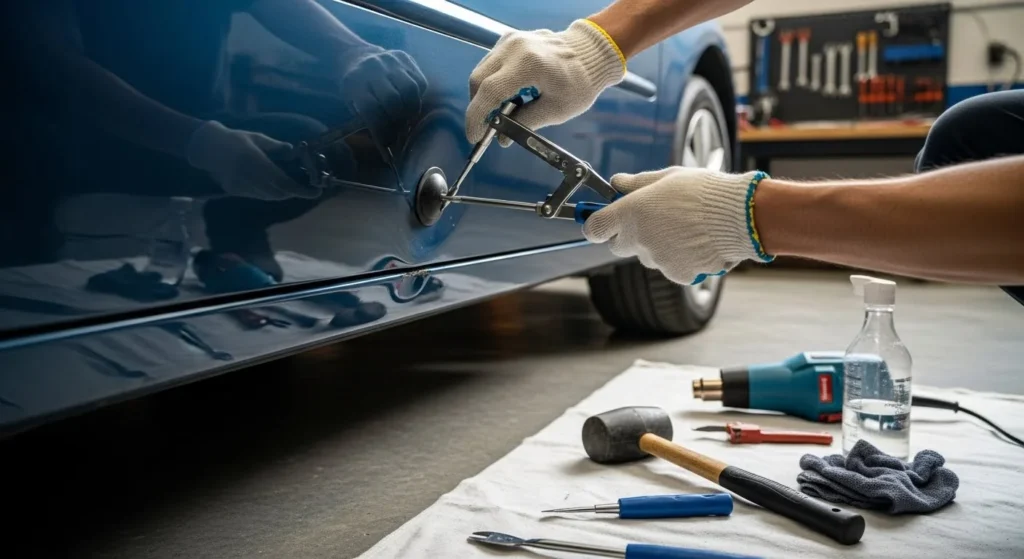DIY Dent Repair: When It Works and When It Doesn’t
There are two great qualities to have as an adult. One is to be able to do things yourself. If you know how to cook tasty and healthy meals, you can save money by not eating out often. If you know how to fix certain computer issues, you don’t have to take it back to the store whenever you have a problem. And if you can fix certain car problems, you may not have to go to an auto body repair shop as often.
The other valuable quality to have is to know when to ask for help. It’s great if you’re a do-it-yourself (DIY) type, but this can be a risky approach. There have been many aspiring DIY-ers who tried to repair their toilet, only to end up with a flooded bathroom. The key is to know what you can do and what you can’t. Let’s look at dent repair as an example.

Dent repair: Suitable for DIY?
There are some auto body repairs that really aren’t suitable for DIY-ers unless restoring old vehicles is their hobby. It takes a lot of knowhow and specialized tools to replace a transmission, for example. But dents? They seem simple enough, right? So go ahead, take a hammer to your car and smooth that dent out.
To many of you reading, that sounds insane. And for you, it is! While hammering out dents is a technique that technicians at dent repair shops sometimes use to fix a dent, it’s not something for the uninitiated. Unless you’re trying to learn how to do it on an old beater of a vehicle, maybe you want to leave that to the professionals.
When to try dent repair yourself
If your primary concern is preserving the value of your vehicle and you’re not a seasoned gear head, then the safest choice is to visit a collision repair shop for your dent repair. But maybe you’re not quite so risk-averse. If you want to try your hand at dent repair, here are some scenarios when it might make sense to go the DIY approach:
When you have small, shallow dents
DIY dent repair is most successful when you’re dealing with small, shallow dents. We’re talking about dents that are less than five centimetres (about two inches) in diameter and without sharp creases. This last part is important, because sharp angles can easily just break if you try to smooth them out.
These kinds of dents often occur from low-speed bumps, hail, or minor door dings; these aren’t the kinds of impacts that mean you have to rush off to a collision repair shop. These lesser impacts don’t distort the metal too deeply, so they’re more forgiving to work with. Attempting to pop them out or smooth them over with suction tools or gentle heat methods can often yield decent results, especially if you’re not aiming for showroom perfection.
If your dents occur on accessible areas
Where a dent is located on a vehicle can greatly affect the practicality of a DIY repair. Flat, open surfaces, such as the middle of a door panel, roof, or hood, are far easier to work on than corners, curves, or areas near seams. These accessible areas can yield enough space to position suction pullers or rods properly. They also allow you to apply even pressure or heat without running into wiring, bracing, or other hidden obstacles behind the panel.
If there’s a dent, but no paint damage
Paintless dent repair (PDR) is a dent repair option when there’s a dent that hasn’t damaged the vehicle’s paint, such as by chipping, cracking, or scratching it. In such cases, it might be possible for you to flex the metal underneath the dent back into place without needing to touch-up the paint. However, you should always inspect the dent closely and in good light. Even if the metal pops back, damaged paint can lead to rust over time. Rust spreads and can eventually compromise the integrity of the panel.
What’s more, this can actually happen on the underside of the panel, where you can’t see it. This means you might not know about the damage until a collision occurs and the panel cannot provide proper protection. If, when inspecting a dent, you notice the paint might be damaged, it’s usually best to consult a professional at an auto body repair shop to avoid further corrosion or mismatched touch-ups.
When you have the right tools
We’ve mentioned several tools particular to dent repair already. Different DIY kits are widely available and relatively affordable, but results vary based on the quality of the tools and your familiarity with them. A typical dent repair might require suction cups, glue-pullers, and PDR rods. These are tools professional technicians use at collision repair shops, but it might be a lot to expect that you yourself can use them properly.
These tools require practice and patience. If you want to make sure you can use dent repair tools properly, you can take an auto body repair course where you’ll learn to perform certain repairs.
However, after paying for the course and for the necessary tools, there’s little question you’ll have spent more than if you had just visited a collision repair shop and paid for a dent repair. If you want to pursue a lifetime of auto body repair as a hobby—one that probably will save you money on collision repair over time—then dent repair is a great place to start! If you just want a cheap and quick way to fix the problem, then visit a dent repair shop.






